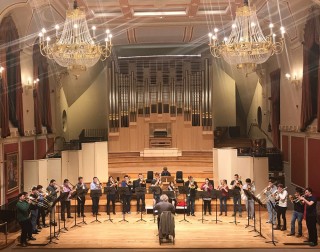Title

Reinhold Friedrich conducts the Juilliard and Royal Academy musicians performing at the academy's Duke's Hall.
(Photo by Liz Williams, Royal Academy of Music)Late on a Sunday night at the end of January, eight of us piled into a van to go from Juilliard to JFK. We were about to fly to London for a 10-day intensive collaboration with students from the Royal Academy of Music. The seven Juilliard students and I were all pretty quiet—we didn't know what to expect. Although Juilliard and the Royal Academy have had a wonderful partnership for nearly 20 years (including orchestral, chamber, new music, and historical performance collaborations), this was the first time that there had been one focused solely on our brass departments. This intensive study and exploration of the music of the 16th-century composer Giovanni Gabrieli would involve more than 20 pieces of music, 30 hours of rehearsal, a performance, and 24 hours of recording sessions, culminating in the release of a CD. The students all had to practice, warm up, cool down, keep up with homework, eat, sleep, and maybe find time to see some sights in London. Would there be enough hours in the day? What would they learn? Would Reinhold Friedrich, the world-renowned trumpeter leading the collaboration, be nice, or would he just make them play until they couldn't play anymore? No wonder everyone was so quiet!
Body
Immediately upon arrival the next morning, the Juilliard students—a combination of undergrad and master's trumpeters and trombonists—headed to the practice rooms reserved for us at the Royal Academy. The next day would include seven hours of rehearsals, so they wanted to be ready.
And ready they were. Friedrich was effusive with his praise for our students from the first rehearsal—for their preparation, knowledge, openness, and responsiveness. It was fascinating to watch the two schools' brass players try to forget their “modern” training (even though they were playing on modern instruments) and, as Friedrich said, “take their playing to the very basic level and start from the beginning together.”
Friedrich had a clear way of explaining what he wanted while being warm, funny, and, most of all, inspiring. He was also generous with his time, spending more than five hours on our day off playing and working with our trumpet players and inviting them to “play just for fun.” While he works regularly with the Royal Academy students, this was the first time he'd worked with Juilliard, and we presented at our best.
During our time together, Friedrich spoke a lot about brass playing of this time period and style as being more like vocal music rather than the developed brass sound we know and love today—these were not the blaring brass lines from a Mahler symphony! And while the music was pure, it was far from simple. As was the tradition of the time, the players could develop various ornaments and add them into the music as they saw fit—what was performed was much more than what was written on the page. Our students spent hours and hours after rehearsal working on ornaments and deciding what worked best in the different pieces. Their diligence paid off in compliments from Royal Academy faculty about the daringness of the ornamentation and how much it had developed over the course of the week. And watching them learn, grow, and change their approach to this music as they became more comfortable with the style of that time period was fascinating.
The concert, performed for a nearly full house in Duke's Hall, went beautifully. And then, after a day off, we prepared for the recording sessions, which took place in the renowned St. Jude-on-the-Hill. Gabrieli composed for musicians to play in churches and frequently placed different “choirs” of musicians throughout to play antiphonally. Friedrich had told us “this music is the playground of angels.” In this beautiful church on a gorgeous springlike day, it was easy to imagine the angels rejoicing in the magnificent sounds of the Juilliard and Royal Academy of Music brass players.




